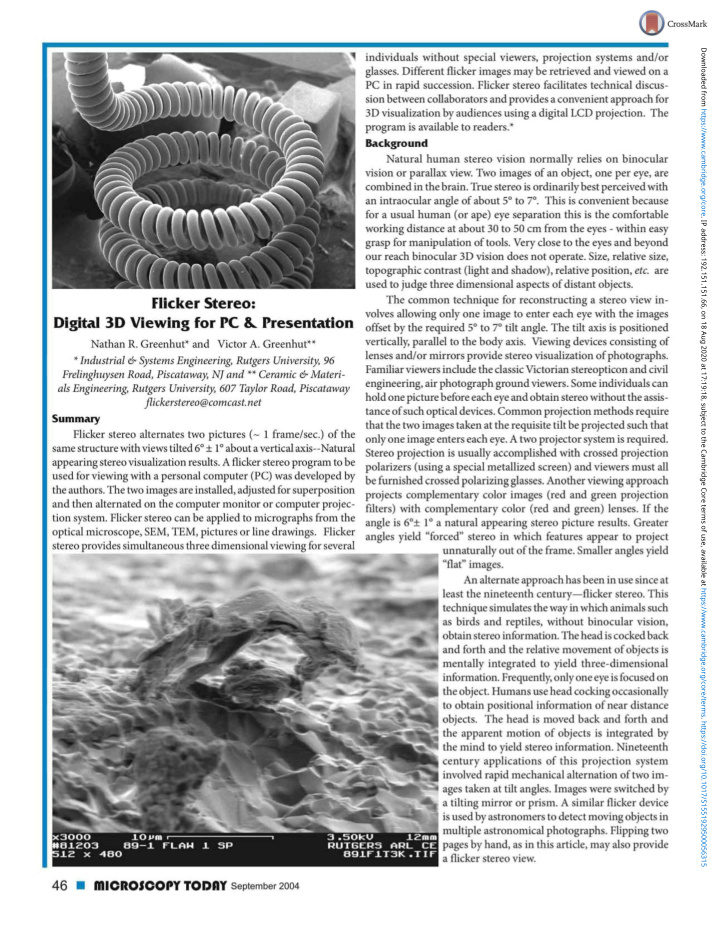



Downloaded from https://www.cambridge.org/core. IP address: 192.151.151.66, on 18 Aug 2020 at 17:19:18, subject to the Cambridge Core terms of use, available at https://www.cambridge.org/core/terms. https://doi.org/10.1017/S1551929500056315 individuals without special viewers, projection systems and/or glasses. Different flicker images may be retrieved and viewed on a PC in rapid succession. Flicker stereo facilitates technical discus- sion between collaborators and provides a convenient approach for 3D visualization by audiences using a digital LCD projection. The program is available to readers.* Background Natural human stereo vision normally relies on binocular vision or parallax view. Two images of an object, one per eye, are combined in the brain. True stereo is ordinarily best perceived with an intraocular angle of about 5° to 7°. This is convenient because for a usual human (or ape) eye separation this is the comfortable working distance at about 30 to 50 cm from the eyes - within easy grasp for manipulation of tools. Very close to the eyes and beyond our reach binocular 3D vision does not operate. Size, relative size, topographic contrast (light and shadow), relative position, etc. are used to judge three dimensional aspects of distant objects. The common technique for reconstructing a stereo view in- Flicker Stereo: volves allowing only one image to enter each eye with the images Digital 3D Viewing for PC & Presentation offset by the required 5° to 7° tilt angle. The tilt axis is positioned vertically, parallel to the body axis. Viewing devices consisting of Nathan R. Greenhut* and Victor A. Greenhut** lenses and/or mirrors provide stereo visualization of photographs. * Industrial & Systems Engineering, Rutgers University, 96 Familiar viewers include the classic Victorian stereopt icon and civil Frelinghuysen Road, Piscataway, NJ and ** Ceramic & Materi- engineering, air photograph ground viewers. Some individuals can als Engineering, Rutgers University, 607 Taylor Road, Piscataway hold one picture before each eye and obtain stereo without the assis- flicke rstereo (Sicomcast.net tance of such optical devices. Common projection methods require Summary that the two images taken at the requisite tilt be projected such that Flicker stereo alternates two pictures (~ 1 frame/sec.) of the only one image enters each eye. A two projector system is required. same structure with views tilted 6° ± 1° about a vertical axis—Natural Stereo projection is usually accomplished with crossed projection appearing stereo visualization results. A flicker stereo program to be polarizers (using a special metallized screen) and viewers must all used for viewing with a personal computer (PC) was developed by be furnished crossed polarizing glasses. Another viewing approach the authors. The two images are installed, adjusted for superposition projects complementary color images (red and green projection and then alternated on the computer monitor or computer projec- filters) with complementary color (red and green) lenses. If the tion system. Flicker stereo can be applied to micrographs from the angle is 6°± l a a natural appearing stereo picture results. Greater optical microscope, SEM, TEM, pictures or line drawings. Flicker angles yield "forced" stereo in which features appear to project stereo provides simultaneous three dimensional viewing for several unnaturally out of the frame. Smaller angles yield "flat" images. An alternate approach has been in use since at least the nineteenth century—flicker stereo. This technique simulates the way in which animals such as birds and reptiles, without binocular vision, obtain stereo information. The head is cocked back and forth and the relative movement of objects is mentally integrated to yield three-dimensional information. Frequently, only one eye is focused on the object. Humans use head cocking occasionally to obtain positional information of near distance objects. The head is moved back and forth and the apparent motion of objects is integrated by the mind to yield stereo information. Nineteenth century applications of this projection system involved rapid mechanical alternation of two im- ages taken at tilt angles. Images were switched by a tilting mirror or prism. A similar flicker device is used by astronomers to detect moving objects in multiple astronomical photographs. Flipping two pages by hand, as in this article, may also provide a flicker stereo view. 46 miCROJCOPY TODflT September 2004
Downloaded from https://www.cambridge.org/core. IP address: 192.151.151.66, on 18 Aug 2020 at 17:19:18, subject to the Cambridge Core terms of use, available at https://www.cambridge.org/core/terms. https://doi.org/10.1017/S1551929500056315 Evex = NanoAnalysis SEM Imaging 857 State Road Princeton, New Jersey 08540 (T) 609-252-9192 www.evex.com (F) 609-252-9091 SHVR/Wave Laboratory Microwave igned for EM & lighi microscopy lissi : ssin» Minima] turn around time, same day n PlDcomml [if actual waliage No vacuum or coldspot required User friendly color touch screen controls Ideal for specimen stabilization & hardening, epitope retrieval and acceleration of decalcification & staining TRIANGLE BIOMEDICAL SCIENCES, INC. 3014 CSOASDAILE DRIVE • DURHAM. NORTH CAROLINA 27705-2507 • USA • 919.3S4.9393 • FAX:919,354.959s • www.1riangleblomedlcal.coin IIIICROSCOPY TODHY September 2004 • 47
Recommend
More recommend